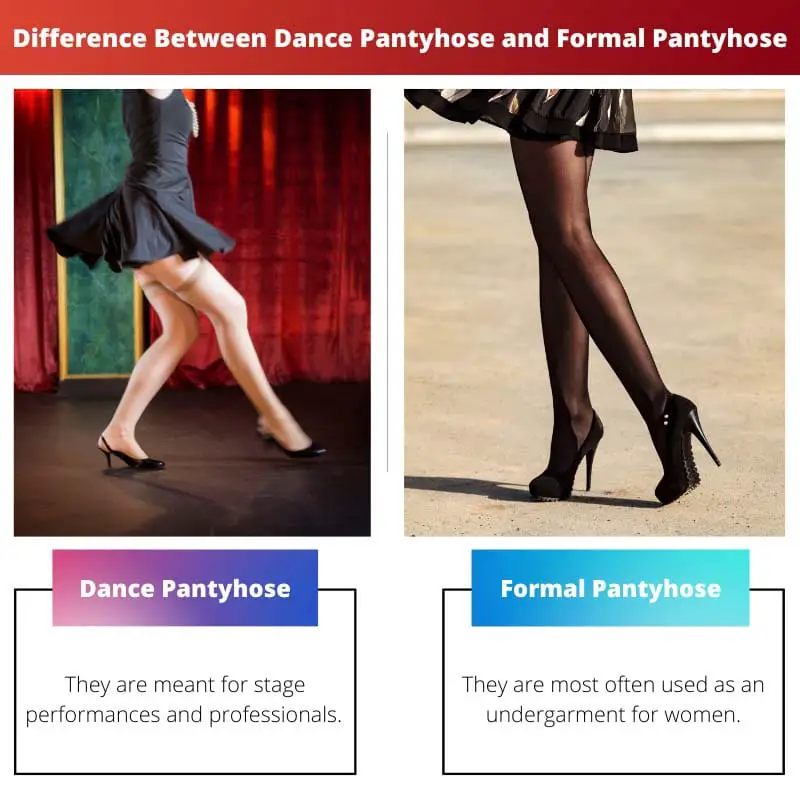Dance and formal pantyhose are considered among the most comfortable legwear and wardrobe options.
Pantyhose is a mixture of an undergarment, a leg warmer or covering, and socks in both forms.
This one-piece garment is frequently worn to cover the legs for warmth or fashion.
Though their features and functions differ slightly, both are commonly used as support and are worn to enhance leg contour and texture, particularly at events where bare legs are prohibited.
Dance pantyhose is referred to as “tights,” while formal pantyhose is called “nylons.”
Key Takeaways
- Dance pantyhoses are designed with durability and flexibility to support the range of motion needed in dance.
- Formal pantyhose prioritizes appearance and may feature sheer fabrics or embellishments for a polished look.
- Both types serve different purposes, with dance pantyhose catering to performers and formal pantyhose enhancing the elegance of special occasion outfits.
Dance Pantyhose vs Formal Pantyhose
Dance pantyhose is lightweight and available in various skin tones, with features such as convertible feet and reinforced toes and heels. Formal pantyhose is made of higher quality, more durable material and may have features such as a control top and reinforced toe and heel.

Dance pantyhose is an essential basic garment in the profession for various artists, such as theatrical actors and dancers.
Due to their comfort, tights were popular among the general population, including men, women, children, and other everyday people. Dance pantyhose is composed of high-gloss fabrics in various colors and hues.
Formal Pantyhose is the tights that women use as an undergarment. They are mostly available in neutral colours like black, white, nude, etc. They are also less sparkly.
They are made of nylon material and are worn underneath an outfit. It has a dernier count of 40 and below.
Comparison Table
| Parameters of Comparison | Dance Pantyhose | Formal Pantyhose |
|---|---|---|
| Purpose | They are meant for stage performances and professionals. | They are most used as an undergarment for women. |
| Dernier Count | 40 dernier count and higher | 40 dernier count and below |
| Colors | They are worn as an undergarment or underneath a business. | They are mostly available in neutral shades like black, white, nude, etc. |
| Material | Spandex | Nylon |
| Wearability | They can be worn as part of an outfit outside the body. | They are worn as an undergarment or underneath an outfit. |
What is Dance Pantyhose?
The most apparent article of apparel connected with performing arts performers is dance pantyhose, sometimes known as tights.
They are skin-tight garments that cover the entire surface of the leg from the waist to the feet. These custom-made clothing are used as primary dance costumes and are meant to offer flexibility of movement, agility, and comfort.
When worn in performance, tights might be plain or bright and sparkling. They are constructed of Lycra and a durable spandex blend. They are thick, with a denier rating of 40 or greater.
The opaqueness and thickness of the tights are due to the high derriere count.
Dance pantyhose or tights are frequently worn by performers on stage and other professionals such as athletes. It is also fashionable for ordinary people to wear, and anyone can do so.
Tights or dancing pantyhose have a denier count of 40 or greater, whereas formal pantyhose has a denier count of 40 or less.
Dance pantyhose comes in a variety of hues. Dance pantyhose is tough, and stretchy and comes in various thicknesses. Because the primary material is spandex, this is the case.
Tights or dancing pantyhose can be worn independently or as part of an outfit. Dance pantyhose is made of durable spandex and have an even width from the waistline to the bottom end.
What is Formal Pantyhose?
Formal pantyhose has long been recognized as an essential aspect of women’s professional attire. However, they aren’t limited to this situation; they can also be utilized to give flair to party dresses.
Despite the emergence of barelegged trends, the use of hosieries to accompany formal clothes remains prominent, regardless of denier. Formal pantyhose are available in various patterns and styles, but they are all made of elastic materials.
Women only wear formal pantyhose in professional and legal situations. It’s light and sheer and only available in neutral colours. Black, brown, nude, and white are examples of these colours.
Because most pantyhose is in these colours, they may be worn with almost any ensemble. Formal stocking is exceedingly fragile, and tears, snags, rips, and runs are all too often. Formal pantyhose, unlike tights, has a denier count of 40 or less.
Formal pantyhose commonly features a sturdy and elastic waistband, a cotton crotch, and a thin material from the legs to the toes. Formal pantyhose should only be worn as an undergarment or beneath an outfit in social situations.
It can also be worn as a one-piece undergarment.
Formal pantyhose is available in various neutral colours, such as black, white, brown, or nude. On the other hand, formal pantyhose is made of nylon.
As a result, this style of pantyhose is delicate, lightweight, and vulnerable to snags, tears, and rips.
Main Differences Between Dance Pantyhose and Formal Pantyhose
- Dance pantyhose is meant for stage performances and athletic professionals. On the other hand, formal pantyhose is used as an undergarment for women.
- The dernier count for dance pantyhose is 40 and higher, whereas, for formal pantyhose, it is 40 and below.
- Dance pantyhose are available in various colours, whereas formal pantyhose are available in neutral shades of black, white, and nude.
- Dance pantyhose is made of spandex, and formal pantyhose is made of nylon.
- Dance pantyhose can be worn as part of an outfit, while formal pantyhose are worn underneath an outfit or as an undergarment.

References
- https://www.cfc.forces.gc.ca/papers/csc/csc45/solo/turcotte.pdf
- https://girikand.com/dctivsdobf/ttrpo-1-at-9578849.html

I had no idea there were so many differences between dance and formal pantyhose. This article is a real eye-opener.
This is a really useful article, it covers everything you need to know about dance pantyhose and formal pantyhose.
The most comprehensive article I’ve seen about pantyhose. No question is left unanswered about this topic.
This article is so thorough, it should be the definitive guide to dance and formal pantyhose. Excellent work.
The amount of detail in this article is truly unmatched!
Couldn’t agree more, the level of detail and thoroughness is extraordinary!
This article really helps differentiate the two types of pantyhose, I will bookmark this for future reference.